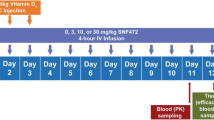Summary
The extracellular fluid is a metastable system with regard to calcium and phosphate ions. Active inhibitors of calcification must be present in serum to prevent the spontaneous formation of Ca2+• Pi solid phases which could otherwise precipitate to cause renal calcinosis and block small blood vessels. α2-HS glycoproteins/fetuins, AHSGs, are ideal candidates for this function. AHSGs are ubiquitous and highly abundant in serum; they bind calcium and efficiently prevent de novo formation of apatitic mineral. Normocalcemic AHSG-deficient mice develop sporadic perivascular calcification. Hypercalcemia induced by dietary means or by hormone treatment results in lethal calcinosis in Ahsg−/− mice. A mineral binding structure is proposed for domain D1 of AHSG suggesting that the proposed EF-hand motif for calcium binding does not exist in AHSG. Unlike serum albumin, AHSG does hot preferentially bind ionic Ca2+, but rather in the form of apatitic microcrystals.
Similar content being viewed by others
Author information
Authors and Affiliations
Rights and permissions
About this article
Cite this article
Jahnen-Dechent, W., Schäfer, C., Heiss, A. et al. Systemic inhibition of spontaneous calcification by the serum protein α2-HS glycoprotein/fetuin. Z Kardiol 90 (Suppl 3), 47–56 (2001). https://doi.org/10.1007/PL00022849
Issue Date:
DOI: https://doi.org/10.1007/PL00022849




